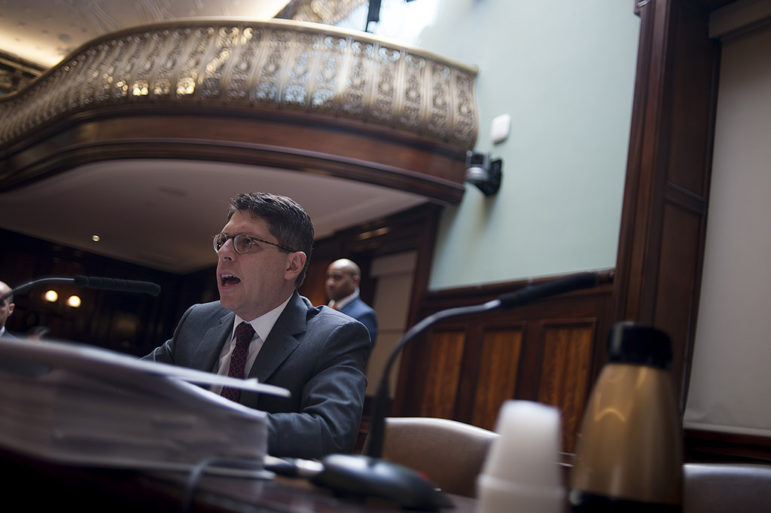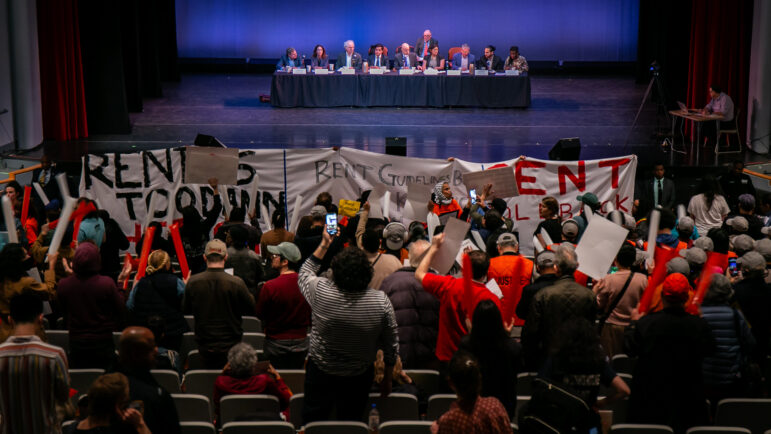
Official NYC Council Photo by William Alatriste
Ousted DOI Commissioner Mark Peters at his 2014 Council confirmation hearing.
Former Department of Investigations Commissioner Mark Peters and Mayor de Blasio have had a nasty breakup in recent weeks, with the mayor and a whistleblower alleging an abuse of power and Peters claiming de Blasio attempted to cover up ugly findings.
Peters has issued a series of reports—hard-hitting or overblown, depending on whose side you take—but a recent one concerning the Administration for Children’s services seems to have some truth to it. That report and an review of ACS data suggest the agency has a growing problem with maltreatment in care.
In FY2014, the Administration for Children’s Services, the city agency in charge of child welfare, reported that there were 3.1 children maltreated per 100,000 days children spent in foster care. That number rose by 140 percent to 7.6 in FY2018. Over the same period, the average number of youth in care fell to 8,732, from 11,750. The total number of days children spent in care fell significantly, also.
According to the report from the Department of Investigation (DOI), the number of children who were maltreated in care rose by 25 percent from 479 to 599 between FY2016 and FY2017. ACS did not respond to a request for total instances of maltreatment in FY2018.
Maltreatment in foster care has come under scrutiny in recent months since the release of the DOI report, which also highlighted that ACS failed to follow up on allegations of maltreatment in care.
The report focused on the six worst performing foster-care providers, per ACS’s internal scorecard system, and found that in FY2017, 86 percent of family foster care providers fell far short of federal standards for preventing maltreatment in care.
The report also said that ACS repeatedly failed to hold providers accountable when maltreatment was documented.
“ACS did not routinely apply increased oversight mechanisms to providers with safety performance issues,” the report said. Such measures might have included heightened monitoring, requiring corrective action or termination of contracts.
It also said the agency didn’t set any minimum performance requirements for providers, either related to its internal scorecard or to the federal guideline.
ACS has said that it cooperated with DOI’s investigation and has agreed to implement new accountability measures. ACS did not respond to an inquiry about the specific details of these measures but they include various ways of holding providers accountable, such as not renewing contracts for low-performing providers and requiring such providers to show a marked improvement in safety.
“We are raising safety standards across the board,” said ACS Press Secretary Chanel Caraway in a statement. She also noted that a contract review process for many city foster care providers is currently under way.
“We plan to rebid our entire foster care system with stringent new standards and there will be providers that may not make the cut. Between now and then, any provider that’s not meeting our standards and fails to show significant improvement will face tough measures up to and including termination of contract.”
Breaking down the data
ACS does not publish detailed data on maltreatment and it is therefore difficult to judge why it might be increasing. However, according to the DOI, many instances of maltreatment occurred outside the foster home, likely when the children were reunited with their families on a trial basis or for a temporary visit.
During this trial period of the reunification process, which lasts a minimum of three months, children in foster care are still technically under the care of ACS and an allegation of abuse, even by a parent, remains the agency’s responsibility.
In 2016 and 2017, individuals other than foster parents perpetrated the majority of instances of maltreatment. The share of maltreatment for which they were responsible also grew. Foster parents were responsible for 115 and 114 instances of maltreatment in 2016 and 2017 respectively.
ACS did not respond to requests for a detailed breakdown of how much or where abuse occurred in FY2018.
Abuse Incidents in Foster Care
| FY2016 | % | FY2017 | % | |
| Total instances of maltreatment | 479 | 599 | ||
| In foster home | 115 | 24% | 114 | 19% |
| Outside foster home | 364 | 76% | 485 | 81% |
Last year, there were an average of 8,732 children in the city’s foster care system on any given day. They are placed in foster boarding homes, residential homes, and sometimes with a foster-parent relative. 54 percent of foster children were in a boarding home. 34 percent were placed with relatives.
The NYC foster care system relies on a network contracted private agencies to provide care. The City spent $540,000 on foster care services in the last budget year.
What’s driving the increase?
There are likely a handful of factors driving the increase in reports of abuse. As reports of maltreatment in foster care have risen in recent years, mostly driven by abuse outside the home, so too have suspected instances of child-abuse generally, in New York City. Even as the number of children entering care has dropped, there were six percent more investigations of abuse in NYC in 2018 than in 2014.
It’s unclear why reported abuse is rising, but it’s possible that it is driven by an increase in concern and awareness about child welfare. Reports of abuse spiked following high-profile mistreatment cases. On Tuesday, ACS announced an awareness campaign to encourage individuals to report suspected abuse.
It’s also possible that the increase is driven by an increasing effort on the part of ACS to reunify children with families that is perhaps leading the agency to do so prematurely.
“It’s really complicated because our goal is to always get kids back home whenever possible. Even when we’re talking about parenting that is far from perfect, it’s in the interest of the child to be with their parents,” said Kerry Moles, executive director of the non-profit CASA, or Court Appointed Special Advocates for Children in NYC
Her point highlights the incredibly thin line that ACS caseworkers must walk. They are tasked with protecting children from abuse, but separating families and placing a child in foster care runs the risk of causing significant further trauma.
“It’s difficult to appreciate what it’s like to try to gauge what it’s like for that young person to return to a family that they might like to return to,” says Glenn Metsch-Ampel, deputy executive director of Lawyers for Children, a legal non-profit that represents foster children in their court proceedings.
He noted that the legal standard the agency and courts must use is one of imminent danger, meaning a child must face a substantial risk of death or harm to their physical emotional or mental wellbeing for a court or ACS to sustain family separation. If that standard does not apply, reunification must be the priority.
It is widely understood in the child welfare community that child abuse is often directly related to poverty. Mental-health issues, addiction and substance abuse, more crowded housing and financial stress are all factors that might contribute to child abuse and arise from poverty, and supporting families with resources and services before potential abuse happens and after family reunification occurs has become a focus for ACS.
Almost all children who were discharged to permanent reunification in the first quarter of 2018—446 out of 490—received preventative services from ACS. However, families have not, until recently, received supports during those temporary reunification periods and that could be a factor contributing to the increase in reports. ACS says that it just launched a program to support families during this period but did not respond with details about how this program will work.
Abuse in the homes
While the majority of maltreatment in care occurred outside of foster homes, the rising rate of maltreatment nonetheless highlights that an alarming number of abuses in the foster home do occur. There were 229 cases reported in FY2016 and FY2017.
“It is absolutely outrageous and unacceptable that any child is abused,” said Moles. “If we’re going to remove them and put them in the care of the stranger, we better make sure that they’re not getting abuse there. That obviously just compounds the trauma greatly.”
Lawyer Carolyn Kubitschek, who has worked on behalf of children abused in care for over 40 years, has reviewed the city’s foster care agency scorecards. She said the line between agencies that perform well and those that don’t is clear, and that the city has not sufficiently incentivized better performance over time.
“If you look at all the data, there are some agencies that consistently have no cases of child abuse—they know how to do it right,” she said, suggesting their model might be easily copied.
Kubitschek and ACS seem to agree that the task, therefore, is cutting ties with the worst performing foster agencies during the upcoming contract renegotiation process. However, it might not be so simple as just getting rid of just a few bad apples given that 86 percent of agencies underperformed, according to the DOI report.
A big obstacle to progress might be a difficulty recruiting qualified foster homes, according to Moles.
“Sometimes it’s hard to close a foster home when there isn’t another one to replace it,” said Moles. “So sometimes, things that are seen as questionable are overlooked, because we don’t have a better option for this kid.”
It’s possible that the falling number of children in care provides an ACS opportunity to demand better quality, according to Kubitschek.
“You’ve got all these foster providers that’ don’t have kids. So as the number of kids who need care goes down, you have the opportunity to weed out the ones that aren’t doing a good job.”
ACS, for their part, says that is the plan.









One thought on “Challenge for City’s Child-Welfare System Overshadowed by De Blasio-Peters Feud”
Pingback: NY: Challenge for the City’s Child-Welfare System Overshadowed by De-Blasio-Peters Feud